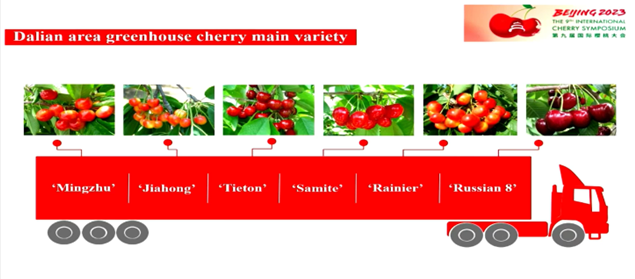At the 9th International Cherry Symposium, held in Beijing from May 22-25, 2023, several papers were presented with the aim to detail the current status of cherry production in different areas of the world.
In this post, we will focus on the work presented by Dr. Hui Zhao, which addresses the topic of greenhouse cultivation,contextualizing it in the Dalian area. This area is located in China's Liaodong Peninsula and is characterized by a continental climate with cold winters and hot, rainy summers. Since the 1980s, greenhouse cultivation has gradually evolved mainly to grow early-ripening cherries, leading the Dalian area to be a leader in this production.
The improvement of greenhouse structure and performance has never stopped, leading to a gradual expansion of this cultivation technique on a large scale within the Dalian area. From 2010 onward, planting technology has improved significantly, leading cherry growers to achieve an income of 1.5 million yuan per ha. 
By 2022, the total area dedicated to greenhouse cherry production in the area reached 6700 hectares, with a total output of 72,000 tons and a generated value of 5 billion yuan. These numbers bring the Dalian area to be the largest greenhouse cherry growing area in the world today.
In detail, the most commonly used greenhouses in the area can be divided into two main categories:
- Warm greenhouse, with an east-west orientation and a glass roof facing south only;
- Cold greenhouse, with a structure that can be either round or ridged, covered with plastic film over the entire surface.
To date, the most cultivated varieties are Hong deng, Tieton and Summit, pollinated with Jiahong, Rainer and Wanhongzhu and others (Figure 1). This rich varietal composition has emerged as a function of early ripening characteristics and fruit quality, particularly color.
Greenhouse cherry production is certainly challenging. In fact, several management aspects need to be considered for successful production. The choice of variety plays a key role, as it must be both early maturing with both red and yellow coloration.
In addition, throughout the growing season, temperature and humidity must be carefully monitored and adjusted with ventilation and timely removal of curtains, as each phenological stage requires precise temperature and humidity values. From the management challenges described above, there is also the need to optimize the fertilizer and water resources management, as well as the management of plant crop load.
In a context of climate change such as the one we are experiencing nowadays, greenhouse cultivation has the significant advantage of changing the microclimate of plants, thus also avoiding damage due to adverse weather events (such as, for example, late frosts). At the same time, however, this advantage is paid for in terms of higher energy inputs required to complete the production cycle.
Despite the possible disadvantages of this cultivation method, fruit growers in the Dalian area want to keep on improving. Indeed, the next challenges include sustainable pest and diseases management, expansion of sales channels, and optimization in the level of mechanization.
Melissa Venturi
University of Bologna (IT)
Cherry Times - All rights reserved











